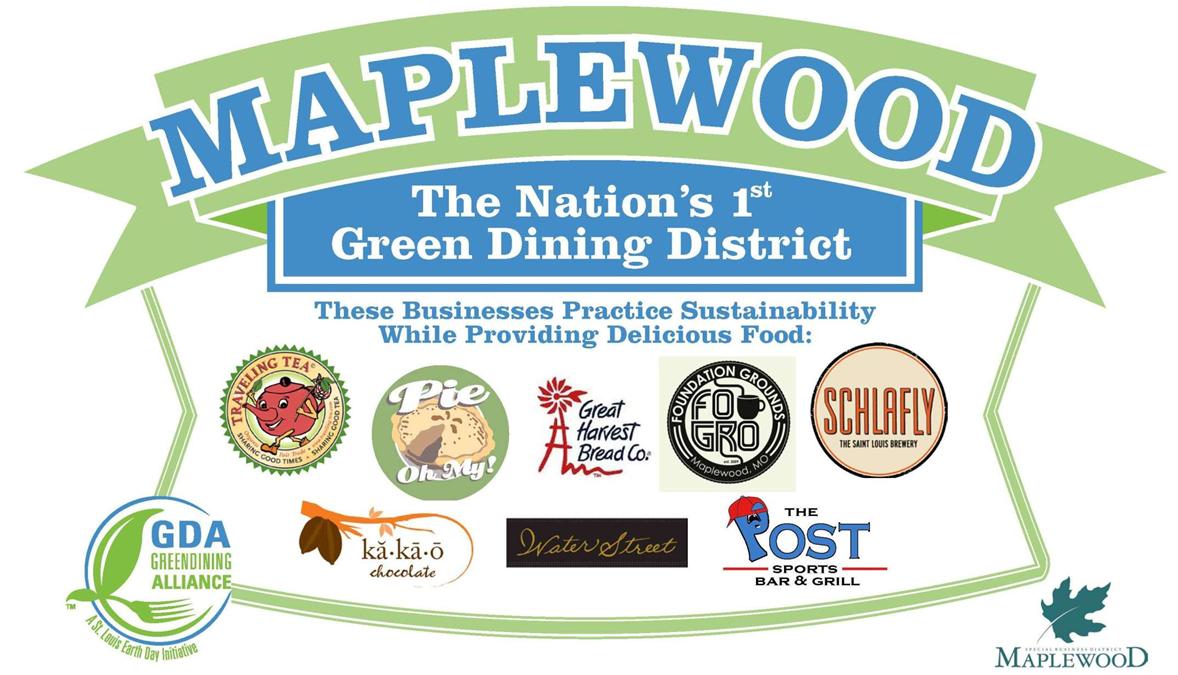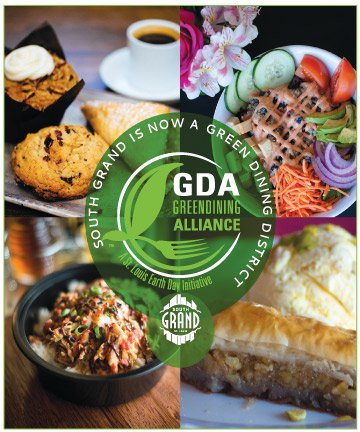Green Dining Districts
St. Louis is famous for its neighborhoods, which are defined by their own unique clusters of restaurants and shops, each with their own distinct brand of character, architecture, and ambiance. The Green Dining Alliance can help add sustainability to a neighborhood’s list of defining characteristics through our Green Dining Districts.
Green Dining Districts bring community leaders and business owners together to achieve GDA Membership for at least 25% of locally-owned restaurants in a Business District – creating destinations for St. Louisans who are looking for environmentally-responsible businesses for their dining experiences.
Becoming a Green Dining District can strengthen the local economy, dramatically lower waste sent to the landfill, reduce emissions, and improve the overall sustainability of the region. Green Dining Districts provide opportunities for collaboration, shared resources, and co-promotion for all of your environmental efforts. When they work together, neighboring restaurants can combine their trash, recycling, and compost services to get a better price, while also increasing their waste diversion from landfills. It is easier to leverage better pricing or pay less in shipping for compostable products if they team up and place one large order together.
Green Dining Districts can be initiated by an anchor restaurant, a concerned citizen, a special business district, and/or the local government.
St. Louis’ 1st Green Dining District – Maplewood
Maplewood’s Special Business District is a walkable community, intentionally devoted to local artisans and eateries. They are also the very first Green Dining District. We’ve already certified a number of restaurants on the strip, and more are lined up to join.
We’re working closely with the Maplewood Special Business District, which is actively encouraging the green dining movement in their restaurants in a number of ways.
Check out a map of Maplewood’s Green Dining District on their website!

Our 2nd Green Dining District: The Loop
The Loop has embraced the concepts of sustainability and has worked hard to become a Green Dining District. Their position as a tourist destination means that the environmental practices they’ve implemented will reach far and wide, promoting St. Louis as a city that cares about its impact. Read more about The Loop’s Certification here, and check out a Loop-specific map of GDA restaurants here!

The City of St. Louis’ 1st Green Dining District: South Grand
South Grand’s Green Dining District offers a stunning array of plant-based foods, encouraging diners to choose delicious plant-based alternatives to resource-intensive meat products. South Grand’s commitment to sustainability goes beyond restaurant greening, especially when it comes to protecting our watershed. The district has permeable pavement, 14 raingardens, 32 rainscaping locations, and educational signage about watersheds throughout the strip. Learn more about South Grand’s Green Dining District here.

The 4th Green Dining District: The Grove
The Grove, located on Manchester Ave between Kingshighway Blvd. and Vandeventer Ave, offers a great selection of sustainable places to eat and drink all in a very walkable area. Our newest Green Dining District offers everything from Urban Chestnut’s LEED-certified brewery to locally-brewed kombucha, catering to coffee, and many other options. Read more about The Grove here.

Making eco-friendly changes can be expensive on the front end, even if it saves money later. Getting local leaders, government, and business owners to work together in sustainability efforts lightens the initial financial load for individual businesses.
1. If you are involved in a community improvement program, special business district board, or city council, a great way to facilitate sustainability is through your group. Look into offering stipends for banning Styrofoam, or to subsidize recycling and compost hauling costs. See if the district is eligible for solar energy, or consolidating the waste hauling system to reduce traffic, noise, and air pollution while offering access to recycling and composting to your restaurants.
2. If you are a supplier for restaurants, consider organizing a discount on eco-friendly and sustainable supplies for GDA Members in your neighborhood. Talk with the GDA about previous models like this that we’ve helped put together.
3. If you are a restaurant owner, spreading the word person-to-person is often the most powerful way to bring someone new on board. Talk to your fellow restaurant owners in the area and show them how your practices have changed to become more eco-friendly. Your influence can go far in your community.
If you are interested in greening your neighborhood, contact Charlie Hall at charlie@earthday-365.org


